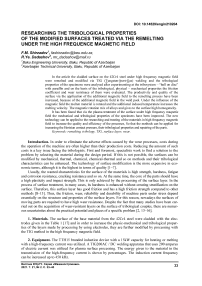Researching the tribological properties of the modified surfaces treated via the remelting under the high frequence magnetic field
Бесплатный доступ
In the article the cladded surface on the 42Cr4 steel under high frequency magnetic field were remelted and modified via TIG (Tungsten-Inert-Gas) welding and the tribological proporties of the specimens were analysed after experimenting at the tribosystem - “ball on disc” with paraffin and on the basis of the tribological, physical - mechanical properties the friction coefficient and wear resistnace of them were evaluated. The productivity and quality of the surface via the application of the additional magnetic field to the remelting process have been increased, because of the additional magnetic field in the weld pool. Under the influence of the magnetic field the molten material is rotated and the additional induced temperature increases the melting velocity. The magnetic rotation mix of alloys and gives to the surface high homogeneity. It has been found that via the plasma treatment of the surface under high frequency maqnetic field the mechanical and tribological properties of the specimens have been improved. The new technology can be applied to the researching and treating of the materials in high frequency magnetic field to increase the quality and efficiency of the processes, So that the methods can be applied for increasing the Hertzian contact pressure, their tribological properties and repairing of the parts.
Remelting, tribology, tig, surface layer, wear
Короткий адрес: https://sciup.org/147233504
IDR: 147233504 | УДК: 621.43.038.6:669.268 | DOI: 10.14529/engin210204
Список литературы Researching the tribological properties of the modified surfaces treated via the remelting under the high frequence magnetic field
- Shirzadov F.M. Osnovy tribologii. Uchebnoye posobiye (na azerb yazyke) [Basics of tribology. Study guide (in Azerb)] .BIU, 2018. 272 p.
- Shirzadov F.M. Erhöhung der Verschleißbeständigkeit von Ventiltrieb-Werkstoffpaarungen mittels unterschiedlicher Randschicht-modifikationen. Dissertation, Berlin, 2012. 178 p.
- Lyakhovich L.S., Isakov S.A., Kartoshkin V.M. et al. [Laser Alloying]. Metallurgy and heat treatment of metals. Moscow, 1987, no. 3, pp. 14–19. (in Russ.)
- Sadikhov A.I. Tekhnologicheskiye osnovy povysheniya iznosostoykosti pretsizionnykh par v mashinostroyenii metodom naneseniya plazmenykh i diffuzionnykh pokrytiy: doktorskaya dissertatsiya po tekhnicheskim naukam [Technological foundations for increasing the wear resistance of precision pairs in mechanical engineering by the method of applying plasma and diffusion coatings: doctoral dissertation in technical sciences]. Bakı, 2008. 250 p.
- Kuhn M., Hammerl C. Diamantähnliche Kohlenstoff-Schichten für tribologische Anwendungen. Deutschland: Oberflaeschentechnik, 2001, Band 61, pp. 121–127.
- Heck K. Einfluss der Prozessführung beim Umschmelzhärten auf die Randschichteigenschaften von Nockenwellen aus ledeburitischem Gusseisen. Diss. für Dr.-Ing. München, 1983,173 p.
- Kirschner J. Tribologische und kinematische Untersuchungen an einem Nocken – Rollenstößel – Trieb. Diss. für Dr.-İng. Karlsruhe, 1988, 285 p.
- Czichos H., Habig K.-H. Tribologie. Berlin, Handbuch, 2010. 757 p.
- Pigors O. Werkstoffe in der Tribotechnik. Reibung, Schmierung und Verschleißbeständigkeit von Werkstoffen und Bauteilen. Leipzig, Stuttgart, 1993. 546 p.
- Brand J, Beckmann C, Münnich T, Filfil T. Tribologische Optimierung von Ventiltrieben durch Beschichtungstechnik. Tribologie Schmierungstechnik, 2001, vol. 48, pp. 22–26.
- Glaeser W.A. Materials for Tribology. Elsevier science publishers, 1992. 259 p.
- Kuhn M., Hammerl C. Diamantähnliche Kohlenstoff-Schichten für tribologische Anwendungen. Dünne Schichten, 2009, Jahrg. 63, 4, pp. 30–31.
- Musayev Y.B. Verbesserung der tribologishen Eigenschaften von Stahl/Stahl-Gleitpaarungen für Präzisionsbauteile durch Diffusionsmetallisieren im Vakuum. Diss. Universität Erlangen – Nürnberg, 2001. 180 p.
- Holland J. Degenhardt Ch. Untersuchung des Temperaturverhaltenes von Nockentrieben. MTZ, 1988, 49(10), pp. 391–395.
- Willermet P.A. The composition of lubricant – derived surface layers formed in a lubricated cam/tappet contact II. Effects of adding overbased detergent and dispersant to a simple ZDTP solution. Tribology International, 1995, 28(3), pp. 163−165.
- Vlotho H.U. Zur Reibung von Nockentrieben mit Flachstößeln. Konstruktionstechnik. Düsseldorf: VDI-Verlag GmbH, 1985. 134 p.
- UTP Stabelektroden, Massivdrähte und -stäbe, Fülldrähte, UP-Drähte und UPPulver, Lote und Flussmittel, Metallpulver. Schweißzusatzwerkstoffe für Unterhalt, Reparatur und Fertigung, UTP Schweißmaterial GmbH, 2004, 465 p.
- Springborn U, Wäsche R. Kohlenstoffnitrid-Schichten für industrielle Bauteil- und Werkzeuganwendungen, Aktenzeichen, 14751N, Abschlus-sbericht, Berlin, 2009, p. 89.
- Waesche R. Grundlagen der Schwingungsverschleißprüfung. TAE Esslingen + GfT: Seminar: Reibung und Verschleiß von Werkstoffen, Bauteilen und Konstruktion, 2008, p. 231.
- Waesche R., Yarim R., Dieter K., Manfred H. Oscillating Sliding Wear Behaviour of SiC, TiC, TiB2, 59SiC-41TiB2 and 52SiC-24TiC-24TiB2 Materials up to 750 °C in Air. Lubrication Engineering, 2006, vol. 12, iss. 2, pp. 99–111.


